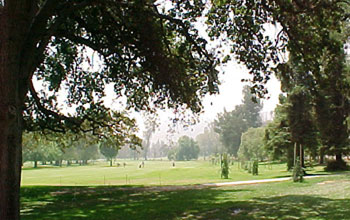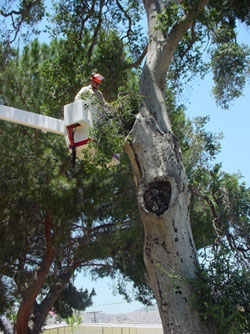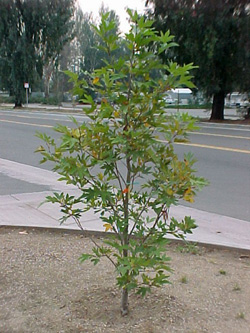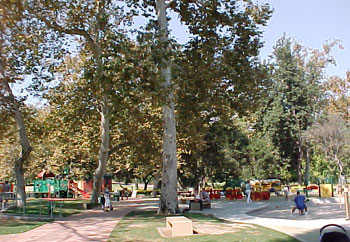The City of Los Angeles Department of Recreation and Parks owns more than 15,000 acres of parkland that provides multi-use opportunities for Los Angeles residents and visitors.
The Forestry Division, which maintains the trees in city parks, is dedicated to providing an attractive, safe, and beneficial urban forest through high quality tree management and maintenance practices with respect to the ecosystem, while serving the needs of the Department, the community, and all park visitors.

The role of L.A.'s urban forest - including the trees in our parks - is to improve the environmental quality, and increase the economic, physical, and social health of our communities. Urban forests are important to quality of life as communities continue to grow. Urban forests also provide energy benefits, improve air and water quality, and offer such social benefits as noise abatement, establishing wildlife habitats, reducing exposure to ultraviolet light, allowing people to experience nature, improving health, creating jobs and educational opportunities, and increasing land value.
The Department's Forestry Division recognizes the importance of trees in the urban ecosystem. During the nesting season, pruning crews look for signs of bird nests. If it is determined that pruning a particular tree or any others around it may disturb a nest, the work is scheduled for another time.
 |
 |
| A Department of Recreation and Parks Forestry employee shades an owl's nest from the direct sun, after the neighboring tree fell down. | |
The Department has evaluated all of its park sites for the opportunity to plant young trees and has incorporated this information into the Reforestation Program. During this evaluation, staff assessed the general age of trees and the variety of species. Functionality and use of the parks were also taken into consideration, as was the extent to which individual parks support wildlife and belong to one of the five watersheds within the Los angeles Basin.
In January 2004 the Department began a tree inventory using a system that will provide detailed information on tree species and the value of its characteristics in relation to active and passive recreation, its cooling/shading effects, as well as its ecological and financial benefits. Global Positioning System (GPS) is used, which is able to record the location of park trees with an accuracy of less than 12 inches by using satellites. GPS recorded information is then transferred onto a Geographic Information System (GIS) ArcView map. Field collected data is than enriched with information entered into the Data Base linked to the individual tree species. The tree inventory of an estimated hundred thousand trees in City Parks is a large undertaking. Staff has begun the inventory of one of the most valuable trees in City parks - the Heritage Trees. (please see link to heritage trees). This project is continually progressing. It is the Department's goal to make the Heritage Trees map available to the public via this web site soon and to invite you to visit our parks and enjoy our unique trees. The tree inventory also provides opportunities for the Department to offer nature related programs to schools and to the public.
The Reforestation Program encompasses long-range plans (10 or more years), intermediate-range plans (5 to 10 years), and short-range goals (from now until 2005) to continue to rejuvenate our parks with young and healthy trees. The Department of Water and Power's Trees for a Green L.A. program will provide the majority of trees for this program. In addition, our Department's staff has been writing proposals for grants to fund the planting of additional trees to beautify our parks and make them an even greater asset.
 New trees that are planted in our parks provide a broader variety of species so that parks do not experience a loss by an unexpected plague, similar to the eucalyptus tree situation. The Department's planting guidelines identify specific criteria to be met in tree selection. One of them is that native California species from within five watersheds of the Los Angeles City parkland are preferred for planting if the location is adequate. Another is that the structural integrity of a species is strongly evaluated in the selection process, and third is to avoid a monoculture. Non-native trees from a diverse species list are recommended if they achieve a ratio of no more than 30% of one genera, 20% of one species, and 10% of one cultivar.
New trees that are planted in our parks provide a broader variety of species so that parks do not experience a loss by an unexpected plague, similar to the eucalyptus tree situation. The Department's planting guidelines identify specific criteria to be met in tree selection. One of them is that native California species from within five watersheds of the Los Angeles City parkland are preferred for planting if the location is adequate. Another is that the structural integrity of a species is strongly evaluated in the selection process, and third is to avoid a monoculture. Non-native trees from a diverse species list are recommended if they achieve a ratio of no more than 30% of one genera, 20% of one species, and 10% of one cultivar.
The ideal park tree is a shade tree that is not susceptible to wind damage and branch drop, does not require frequent pruning, produces slight litter, is deep-rooted, has few serious pest and disease problems, and tolerates a wide range of soil conditions, irrigation regiments, and air pollutants. Since relatively few trees have all of these traits, it is important to match the tree species to the planting site by determining (on a case-by-case basis) what issues are most important.
The Department is also working with community-based organizations that have a longstanding commitment to tree planting in the City of Los Angeles and have offered to assist in our replanting efforts. These groups are the Los Angeles Conservation Corps, TreePeople, the Hollywood Beautification Team, and North East Trees.
Monetary contributions to the Department's reforestation program are also being accepted from the public, with our commitment to use the money to plant trees in parks where they are most needed and as identified in the Reforestation Program. Regrettably, it is not possible to install memorial plaques, as they can damage a tree.

Please call the Forestry Division at (213) 485-4826 to obtain more detailed information about our Department's Reforestation Program or to donate to this project.